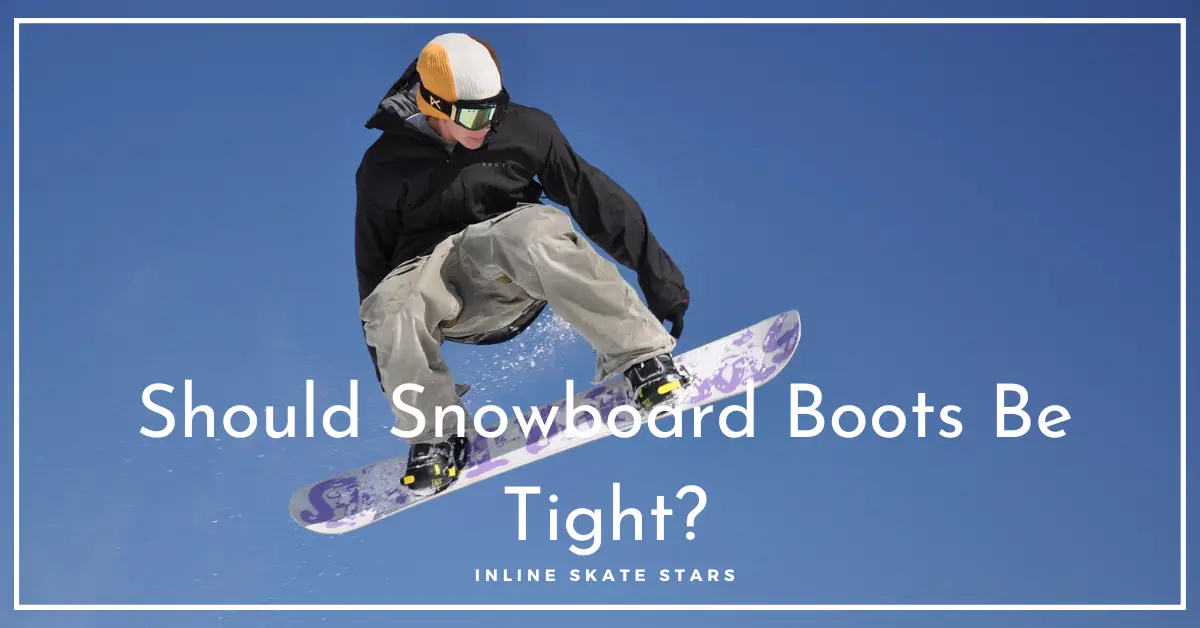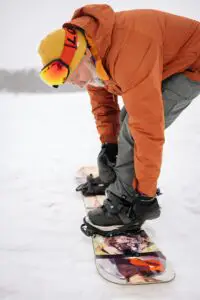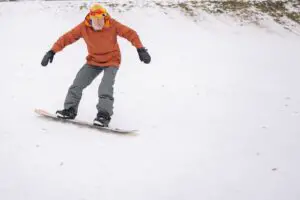You need well-fitting snowboard boots for the best possible snowboarding experience and fun.
The boots come in a variety of sizes, colors, and materials. When choosing boots, one should better understand and assess the advantages and disadvantages of wearing tight boots.
A properly sized boot should be snug without creating pressure points on the top of your feet, heels, or toes.
This will reduce the risk of calf and ankle injuries from snowboard boots that are too tight or too loose.
Furthermore, your boot tightness goes hand in hand with your boot warmth and comfort.
How warm and cozy your feet are will determine how long you stay on the mountain.
You can make the most of your time on the mountain with comfortable, warm, and properly fitting boots.
Therefore, the design of the boot should be able to withstand the worst mountain conditions.
Choosing the right fit can be daunting, especially for a beginner. Suppose you’re debating whether to go with a tight one or not.
Worry less because this guide has the solution to your problem.
Let’s roll it!
Should Snowboard Boots Be Tight?
Should snowboard boots be tight? Snowboard boots should not be too tight.
Your feet should have a snug fit, neither too tight nor too loose. When your boots are too tight, you will experience cramps, bruises, and pain around your pressure points. That is, on your ankles and calves.
How Tight Should Snowboard Boots Be?
Your snowboard boots should have a snug fit, neither too tight nor too loose. Your feet should feel easy, restful, cozy, and comfortable inside the boots.
This helps avoid injuries, bruises, and cramps around the ankles and calves. When your boots are too tight, you will feel pinching on your toes, heels, and ankles.
Also, riding in tight boots will make it hard for you to control the board at high speeds.
Additionally, they will make it hard to make turns at low speeds. In both situations, you will feel pinching and pain in your ankles and calves.
Your boots are too tight if you feel squashed on the toes or the sides of your feet.
Your feet instep should relax comfortably on your boot’s footbed.
A fit snowboard will also help keep the cold away. It’s also necessary to provide your feet with warmth, comfort, and protection.
A well-fitting snowboard boot should have enough room for your toes to stretch freely without constriction.
When you have your boots on, your big toes should be in loose contact with the front of the boot.
They should offer good air circulation for warm feet but not be too loose for your feet to move inside the boot.
Loose boots will make it hard to control your board and will be extra work for your feet and ankles.
When wearing your boots, bend slightly at the knees, which is the snowboard riding position.
If your toes are crammed or curled, the boot is tight. Your toes should barely touch the front of the boot at this position.
What Determines Your Boot Fitness?
Several factors influence your boots’ tightness. The features are heel fit, socks, linings, footbeds, and boot lacing systems. They are covered below in detail.
1. Boot Lacing System
A good lacing system should have precise adjustability to your boots, avoiding pressure around your ankles and calves.
Snowboard boots come with three lacing systems—traditional, quick-pull, and BOA lacing systems.
- Traditional laces are similar to shoe laces. They are the cheapest of the three lacing systems. They are easy to tighten but break easily, although their replacement is easy to find.
- Quick-pull is easy to lace. You just need to do a quick lace pull. They tighten the boots neatly and efficiently, with custom-fit options around your ankle and middle feet.
- A BOA system is the best but the most expensive. It offers an easy, fine-tuned fit from the featured dual-dial system. They make the boots costly and are very hard to replace.
2. Comfort
Like roller skating, snowboarding requires you to be comfortable in your boots for better riding.
Being on your feet while snowboarding requires more comfy boots that can withstand the pressure from your weight.
When riding, turning, jumping, and taking a stance, pressure is created. Therefore, wearing tight boots will make these maneuvers quite complex and extremely painful.
3. Heel Hold
Your heels should be snug enough to avoid lifting inside the boots. Tight heel grips develop pressure points, causing injuries to your ankles and calf.
Therefore, your heel hold should be tight enough to avoid movement of the heel inside the boot.
A loose heel hold negatively impacts how responsive your board is. Getting your board to respond will take more work and time when your heel is loose.
It becomes difficult to perform quick maneuvers or land from jumps.
Furthermore, your boots become unpredictable. You use too much of your muscles to press down on the boots to get the board to respond.
As a result, you experience fatigue and cramps in your muscles.
4. Boot Socks
Your snowboard socks should be light. It’s best to avoid wearing bulky socks because they will make your boots tighter. Moreover, bulky socks will make your feet sore.
Your socks should be thin and smoothed-faced for your feet’ comfort.
Lighter socks will also help with good breathing and air circulation in and out of the boot.
The best sock materials for snowboard boots include synthetic blends, such as nylon, polypropylene, fleece, wool, and silk.
The fabrics are light, breathable, easy to clean, and dry fast.
5. Snowboard Liners and Footbeds
Comfortable and fitting liners and footbeds are necessary when riding for long hours. They provide comfort and warmth for a better snowboarding experience.
Liners are the removable inner parts of snowboard boots. The liners are cushioned, providing warmth, stability, and protection for your feet.
Snowboard footbeds are the insole part of your boot. They should fit the natural instep of your feet for better comfort and less strain.
Your footbed should not be too large or too small to avoid pain in the feet, heels, and ankles.
Oversized footbeds make your boots feel too tight, and your feet overly squeezed.
Should Snowboard Boots Be Tight? | Conclusion
Should snowboard boots be tight? Snowboard boots should b a snug fit. They should not be too tight or too loose to avoid pressure points. Possible pressure points include your ankles and calves.
A good snowboard boot should make your feet feel easy, restful, cozy, and comfortable.
The right snowboard boot fit should also provide warmth, comfort, and protection.
There you have it! You now understand the kind of boot to go for when it comes to its tightness.
Find a boot that will protect you from ankle and calf injuries while riding. See you on the slopes!




